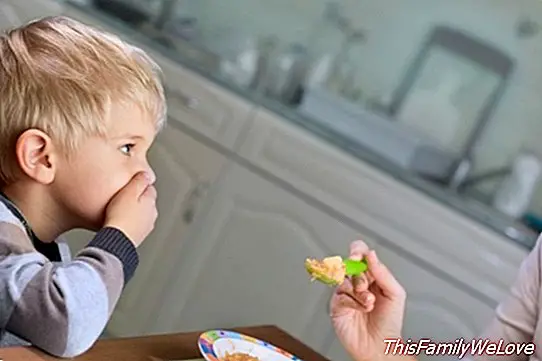The 7 big mistakes to teach children to eat


Sometimes, teach children to eat "Everything" and, especially, in a healthy way is not an easy task, but it is very necessary for them to grow up healthy. This is remembered from the Spanish Association of Pediatrics in Primary Care (Aeped), which ensures that adaptation to new foods is a process that can be preceded by numerous "frustrated attempts".
The family offers the child various foods with the objective of recognizing them, accepting them, proving them, liking them and, of course, I eat them with pleasure. "This process requires a trial and so the child needs their time," say pediatricians, who say that the refusal of food is nowadays one of the great reasons why parents come to their consultations.
At this point, they remember a maxim: "by repetition certain habits, norms and limits are established" in their relationship with food, so that You have to be patient and, above all, to set an example, since the parents' dietary model "tends to reproduce in their children".
"Patience and perseverance in the family mode of feeding help the child overcome his / her rigidities and fears and behave at the table like the rest of the family", the pediatricians comment about it. In fact, at this point they say that the reluctance to try unknown foods has a name: neophobia, and that it is a universal phenomenon in the animal world since it is used as a "defense mechanism", since it avoids unknown dangers.
The big mistakes when teaching children to eat
Parents, in our eagerness to teach children to eat, sometimes lose patience and despair, but we also make mistakes. "The acceptance of a new food may require numerous frustrated attempts", reiterate the pediatricians, who recommend never throwing in the towel, but "try to offer small amounts of the food that you refuse two or three times a week". The trick for children to learn to eat, they say, is to try "without haste or forcings", but with patience and without fear, so that the time will come when the child will accept the new food.
Between the big mistakes What parents do when we want to teach our children how to eat include the following seven, described by the British pediatrician Ronald Illingworth.
1. Distract the child to eat: to put the television, to read a story to him or even to put music to him that it is distracted is not advisable.
2. Prizes or punishments. Convincing or persuading the child to eat through rewards or punishments is also a common mistake.
3. Blackmail. Related to the previous one, there is blackmail as a method to convince him. Another mistake with which a true learning is not achieved.
4. Force. If in the process for the child to eat everything physically we force him (putting the food in his mouth, for example), what we will achieve is that he "hates" that food.
5. Threatening. While in blackmail we tell our son that if he eats we will give him something, the threat is just the opposite: if he does not eat we will take it away. Both actions are mistakes.
6. Eat what you want. Children can choose the plate of food from time to time, but keep in mind that when a meal is served at home it is for everyone, also for the little ones in the house. We can not create habits in which the little ones know that if they do not like a dish, they can choose another one.
7. Give food "between meals". Giving the child to peck at other times than at lunch thinking that "well, at least, eat something" is another big mistake, we will take away the hunger.
How to motivate children to eat
From the Aeped they assure that the obligation will generate rejection, while the prohibition makes children want what they should not. "This is applicable to food", they say, while explaining that in environments where there is no hunger (today there is no lack of food in almost any home) "children use food as a weapon to confront their parents, even at the cost of not eating. "
At this point, pediatricians reiterate that the most important thing is give an example to the little ones: we are the parents who buy the food, we cook it and we eat it. If children do not grow up in an environment where a food has always been present, then tThey will be more reluctant to try it.
Also, when teaching children to eat, it is also advisable to teach them a routine: the lunch and dinner schedule, order the toys before eating, wash your hands, participate in the preparation of the table, sit down well, use the cutlery, and so on. These are attitudes that will also help children learn to sit at the table and eat what they have that day.
Main challenges when we teach children to eat
Pediatricians warn that it is the lack of educational coordination between parents that facilitates the "emergence and maintenance of random responses," among which are:
- Manias in eating: he only eats one food (always the same, food after meal). Let him eat whatever he wants as long as it is a healthy food.
- Hunger strike: If you refuse to eat what you serve and always want something different, always have bread or fruit at every meal and other foods that you like. Set time limits and do not fear that the child is left hungry.
- TV. It is very common to watch TV while eating, but if it is not turned off you can not talk with your family.
- Whiny habit. He whines or always complains about the food. With these attitudes it is recommended that, if the child does not behave as he should, go to his room or sit away from the table until the meal is over. Then you can not afford to eat anything until the next meal.
- White diet. If you only eat bread, potatoes, pasta and milk and the parents insist that the monotony is bad, we will only get the child to persist.
- Fear of new foods. It is the most common: the child refuses to try new foods. You must continue offering him new foods and encouraging him to eat them. Up to 15 repetitions are required for the child to taste the new food, and you may have to try it several times until you like it. Never force it because you would accentuate its rejection.
Angela R. Bonachera




